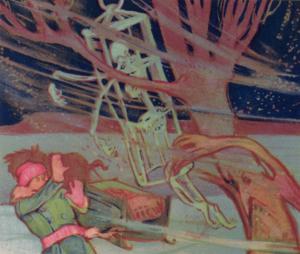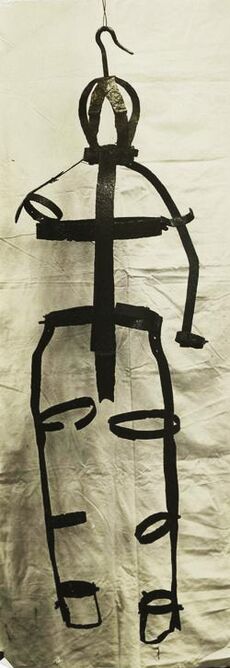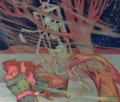Marie-Josephte Corriveau facts for kids
Quick facts for kids
Marie-Josephte Corriveau
|
|
|---|---|

La Corriveau's skeleton terrorising a traveller one stormy night. Illustration by Charles Walter Simpson for the Légendes du Saint-Laurent, 1926.
|
|
| Born | January or February 1733 Saint-Vallier, New France
|
| Died | April 18, 1763 (aged 30) |
| Resting place | Saint-Joseph-de-la-Pointe-De Lévy, Lévis |
| Nationality | New France |
| Other names | La Corriveau |
Marie-Josephte Corriveau (born 1733 in Saint-Vallier, Quebec – died April 18, 1763, in Quebec City), often called "la Corriveau", is a very famous person in Québécois stories and legends. She lived in New France during a time of change. She was found responsible for the death of her second husband. She was then put to death, and her body was displayed in a metal cage as a warning. Her story has become a popular legend in Quebec, inspiring many books and plays.
Contents
Early Life
Marie-Josephte Corriveau was born in 1733. She was likely born in January or February. She was baptized on May 14, 1733, in the small town of Saint-Vallier, Quebec in New France. She was the only child of Joseph Corriveau, a farmer, and Marie-Françoise Bolduc, who survived childhood. Her ten younger brothers and sisters all died when they were very young.
Marriages and a Mystery
Corriveau got married at age 16. On November 17, 1749, she married Charles Bouchard, a 23-year-old farmer. They had three children together: two daughters, Marie-Françoise (born 1752) and Marie-Angélique (born 1754), and a son, Charles (born 1757).
Charles Bouchard died on April 27, 1760. After her second husband died, some people started to spread rumors. They whispered that Marie-Josephte might have caused her first husband's death. However, there is no official proof of this.
Fifteen months later, on July 20, 1761, she married again. Her second husband was Louis Étienne Dodier, another farmer from Saint-Vallier. On the morning of January 27, 1763, Louis Dodier was found dead in his barn. He had injuries to his head. Even though officials said he died from being kicked by horses, rumors of murder quickly spread. People knew that Dodier did not get along well with his father-in-law or his wife.
The Investigation and Trial
At this time, New France had been taken over by the British in 1760. This happened during the Seven Years' War. The British Army was in charge of keeping order. When they heard the rumors about Dodier's death, the local British military leaders started an investigation.
The investigation began in Quebec City on March 29, 1763. It took place at the Ursulines of Quebec. Marie-Josephte and her father, Joseph Corriveau, were accused. They appeared before a military court. This court was made up of 12 English officers and led by Lieutenant Colonel Roger Morris.
Many people from the community gave their statements. This included Joseph's niece, Isabelle Sylvain, who was also Marie-Josephte's cousin. On April 9, the court decided that Joseph Corriveau was responsible for his son-in-law's death. Marie-Josephte was found to have helped in the death. She was given a severe punishment, including a mark on her hand. Isabelle Sylvain, who had changed her story several times, was found guilty of lying under oath. She also received a punishment.
Joseph Corriveau was sentenced to be put to death. He then told his priest that he had only helped his daughter. He said she was the one who had caused Dodier's death. Because of this new information, a second trial was held on April 15. During this trial, Marie-Josephte said that she had caused her husband's death while he was sleeping. She said she did it because he treated her badly. The court found her responsible. They sentenced her to be put to death. After that, her body was to be displayed in a metal cage.
Execution and the Cage
Marie-Josephte Corriveau was put to death in Quebec City. This happened on the Buttes-à-Nepveu, near the Plains of Abraham, likely on April 18. After her death, her body was placed in a metal cage. This cage was then taken to Pointe-Lévy. It was displayed at a busy crossroads there.
People living nearby asked for the body to be taken down. So, James Murray, the military commander of Quebec, gave an order. He allowed the body to be removed and buried.
In 1851, the metal cage was found again. It was dug up from the cemetery of the Saint-Joseph-de-la-Pointe-Lévy church. Soon after, the cage was stolen from the church cellar. It was bought by an American showman named P. T. Barnum. He put it on display as a strange and interesting object. Later, it was shown at The Boston Museum. A note at the museum simply said it was "From Quebec."
Thanks to the efforts of the Société d'histoire de Lévis, the cage was bought from the Boston Museum. Today, it is part of a permanent display. You can see it at the Musée de la civilisation in Quebec City.
The Legend Lives On

When the iron cage was found in 1851, it brought the old legends back to life. Writers in the 1800s made these stories even bigger and more fantastic.
In 1863, Philippe-Joseph Aubert de Gaspé wrote about a supernatural Corriveau. In his book Les Anciens Canadiens, her ghost in the cage terrorizes a traveler one stormy night. She is shown with witches and mysterious lights. Other writers, like James MacPherson Le Moine and William Kirby, later wrote that she was a professional poisoner.
Some writers and historians, such as Louis Fréchette and Pierre-Georges Roy, tried to tell the true story of Corriveau. But it was hard to separate the real facts from the made-up parts of the legends and novels.
Even today, the story of Corriveau continues to inspire new novels, songs, and plays. People still discuss whether she was truly guilty. The oral tradition, meaning stories passed down by word of mouth, is also still very much alive. Many stories about her are still collected from different parts of Quebec.
Images for kids



